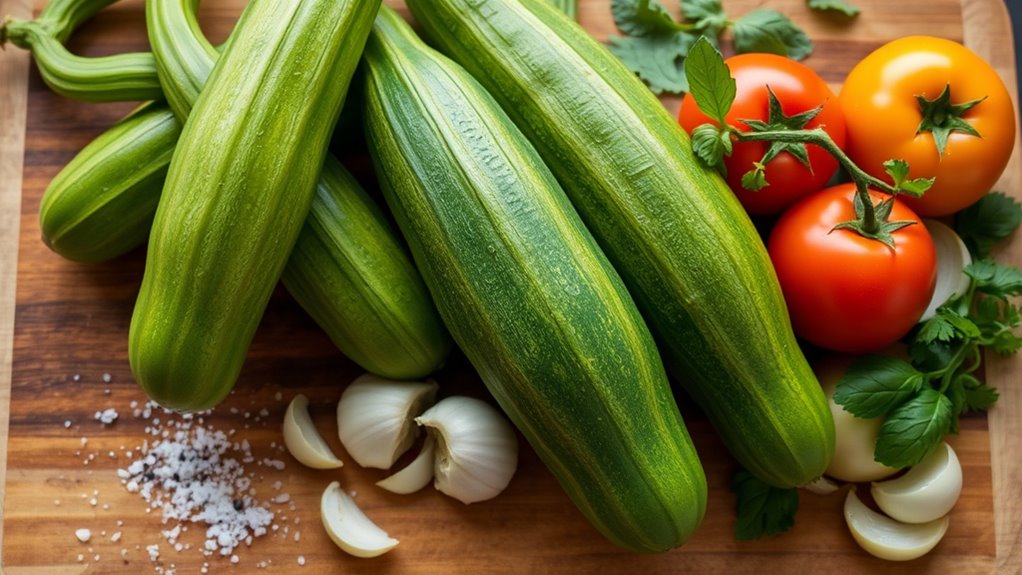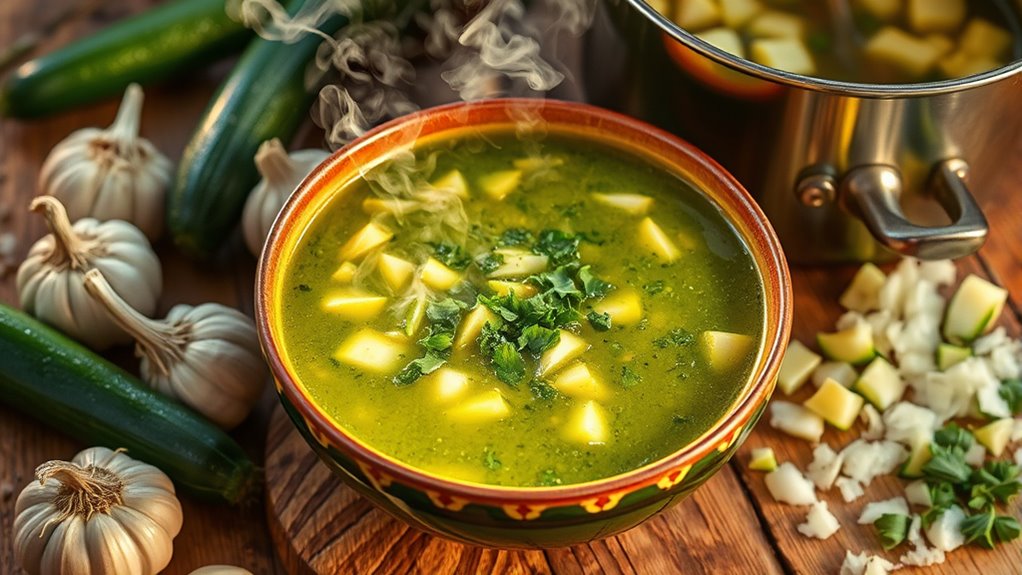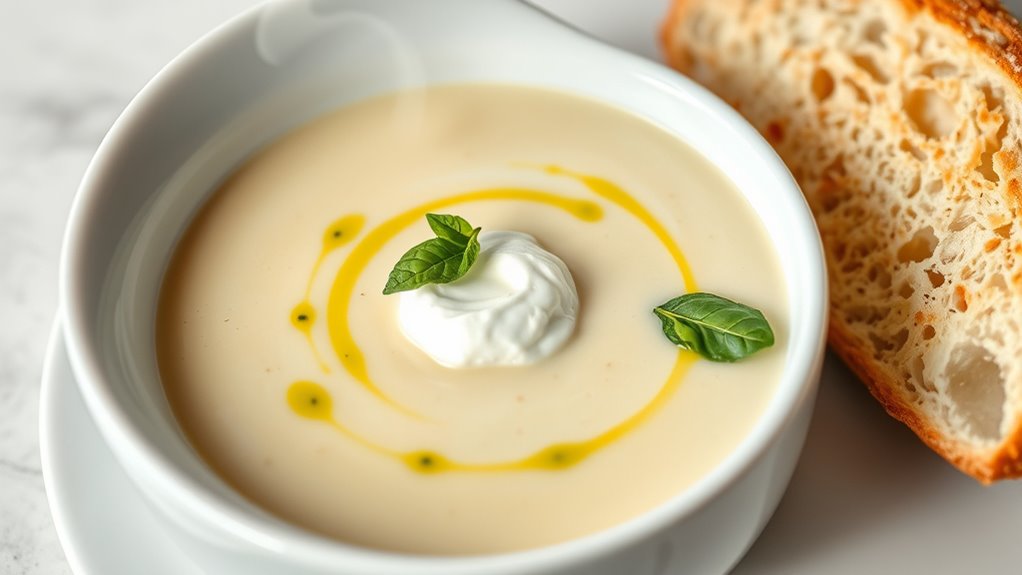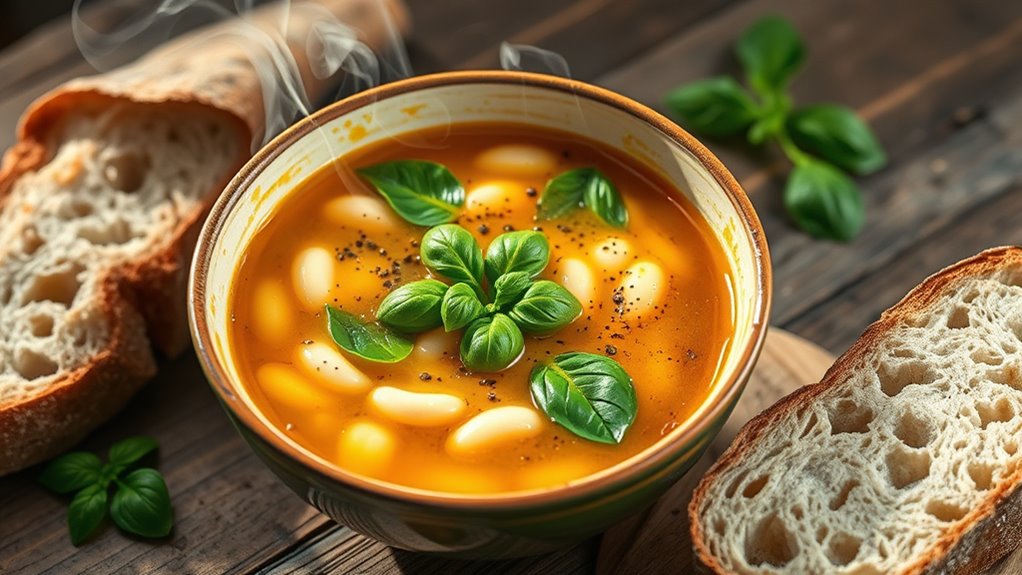This quick cucuzza soup starts by rinsing a medium cucuzza, then cutting it into uniform chunks and patting dry to encourage browning. In a soup pot, sauté onion and garlic until fragrant, then add herbs, optional tomatoes, and 4 cups of stock. Simmer gently with the cucuzza until tender for a light, fiber-rich bowl. It’s low in calories yet high in potassium and vitamins A and C. If you keep exploring, you’ll uncover more flavor-building tips.
Ingredients and Quantity

The ingredients for cucuzza soup are straightforward and balanced, focusing on a few core components that meld into a comforting, light broth. You’ll target clean flavors, measured quantities, and adaptable options, mindful of cucuzza varieties and soup flavoring. You’ll pick tender squash, onions, garlic, olive oil, stock, and a pinch of salt, with optional tomatoes or herbs for nuance. Now, quantify purpose: squash 1 medium, onion 1, garlic 2 cloves, olive oil 2 tbsp, stock 4 cups, tomatoes 1 cup (optional), salt 1 tsp, pepper to taste, herbs as desired. Table captures essentials below.
| Item | Quantity |
|---|---|
| Cucuzza squash | 1 medium |
| Onion | 1 medium |
| Garlic | 2 cloves |
| Stock | 4 cups |
Preparations

To prep the soup, rinse the cucuzza and scrape away any rough skin, then cut it into medium chunks that will soften quickly in the simmering broth. You’ll focus on preparation techniques that preserve texture and flavor while guiding the simmer toward balance. Consider how ingredient preparation shapes outcomes, from bite to aroma.
- Rinse surfaces deliberately to remove impurities without washing away interior sweetness.
- Slice evenly for uniform tenderness and predictable cooking.
- Dry each piece lightly to prevent steam-dampness that weakens browning.
- Set portions aside in labeled containers to maintain consistency during assembly.
Staying mindful of these steps, you maintain control, enabling a clean, expressive soup that honors both technique and freedom.
Kitchen tools or Kitchenware Required

Selecting the right kitchen tools sets the foundation for a smooth cucuzza soup workflow: a sturdy Dutch oven or heavy-bottom pot for even heat, a sharp chef’s knife for clean, precise cuts, and a wide, slotted spoon to lift softened pieces without breaking them. You’ll also want a reliable soup pot, a cutting board, and a dependable pair of tongs to maneuver ingredients with control.
| Tool | Purpose | Benefit |
|---|---|---|
| Soup pot | Simmer broth evenly | Consistent flavors |
| Cutting board | Safe, stable prep | Precise slices |
| Slotted spoon | Lift solids without noise | Clean separation |
How to Cook

- Prep all ingredients before starting.
- Bring a pot of broth to a gentle simmer.
- Sauté aromatics such as onion, garlic, and herbs until their flavors bloom and they soften, avoiding burning.
- Add zucchini or cucuzza in uniform chunks to ensure even cooking.
- Gradually introduce broth while monitoring the simmer to maintain tenderness without overcooking.
- Balance moisture and density to preserve texture.
- Finish the dish with a bright herb note to highlight the flavor pairing without overpowering it.
- Use cooking techniques that respect the squash’s natural sweetness and avoid overcooking.
How to Serve

A simple approach to serving cucuzza soup is to present it in warm bowls with a bright finish that complements its delicate sweetness. You’ll want a clear, intentional presentation that invites tasting before texture. Think about portion control, so each bowl feels generous but refined, and consider a light garnish that speaks to freshness rather than heaviness. For Serving suggestions, keep the broth’s clarity intact, avoiding overpowering toppings. Presentation ideas should emphasize color harmony: pale soup against a white plate, a dollop of ricotta or yogurt for contrast, and a strip of fresh herbs for aroma. Serve with crusty bread or warm focaccia on the side to offer balance. Maintain a calm, purposeful tempo so guests can appreciate every nuanced note.
Tips
To streamline flavor and texture, start with a clean, evenly diced cucuzza and keep the broth at a gentle simmer to preserve sweetness without bitterness.
To streamline flavor and texture, dice cucuzza evenly and simmer gently to preserve sweetness.
1) Observe how different cuts affect cooking techniques, aiming for uniform pieces to guarantee consistent flavor distribution.
2) Taste as you go, adjusting salt and acidity to balance flavor profiles without overwhelming the squash’s natural sweetness.
3) Layer aromatics thoughtfully—onion, garlic, and herbs should support, not dominate, the cucuzza’s character.
4) Finish with a brief rest after simmering so textures settle and the broth clarifies, enhancing overall coherence and clarity.
Food Value and Benefit
Cucuzza soup is a light and nutrient-rich dish that showcases the natural sweetness of the squash while providing numerous health benefits. It is low in calories and packed with essential vitamins, minerals, and fiber, making it an excellent choice for maintaining steady energy and promoting fullness.
Food Value:
- Low in calories
- High in dietary fiber
- Rich in vitamins such as Vitamin A, Vitamin C, and Folate
- Contains essential minerals including Potassium and Magnesium
- High water content for hydration
Benefits of Eating Cucuzza Soup:
- Supports healthy digestion and promotes gut regularity due to its fiber content
- Aids in maintaining healthy blood pressure levels thanks to potassium
- Enhances skin health and hydration with its high water and vitamin content
- Provides antioxidants that help reduce inflammation and boost immune function
- Supports cellular function and overall wellness with folate and other micronutrients
- Complements balanced nutrition with a well-rounded macro- and micronutrient profile
Frequently Asked Questions
Can I Substitute Tomato With Roasted Red Peppers?
Yes, you can substitute roasted red peppers for tomato. Juxtapose bright sweetness with smoky depth; roasted peppers alter the flavor profile, adding aroma and velvety body, while preserving freedom to adapt texture, color, and seasoning to your taste.
Is Cucuzza Soup Vegetarian or Can It Be Vegan?
Yes, it can be vegetarian, and you can make it vegan with substitutions. You’ll swap animal products for vegetarian ingredients and apply vegan modifications, preserving flavor while honoring a freedom-loving palate seeking balanced, inclusive, and clearly defined textures.
How Long Does Leftovers Stay Safe in the Refrigerator?
Leftovers stay safe in the fridge for about 3 to 4 days. For best food safety, keep them in airtight containers, reheat to steaming hot, and discard if you notice off smells or textures. Trust your senses, stay mindful.
Can I Freeze Soup Without Altering Texture or Flavor?
Yes, you can freeze soup without hurting texture or flavor. Freezing tips: cool quickly, portion, and use airtight containers. Texture preservation hinges on fats and starches; avoid over-thickening, and thaw slowly for best, consistent results.
What Are Common Regional Variations of Cucuzza Soup?
Cucuzza origins point you toward Italian-American and Mediterranean roots, and regional ingredients diversify the soup: you’ll find zucchini-like squash, chickpeas, garlic, herbs, and peppers. You pursue authenticity, savor tradition, and celebrate adaptable, freely crafted flavors.
